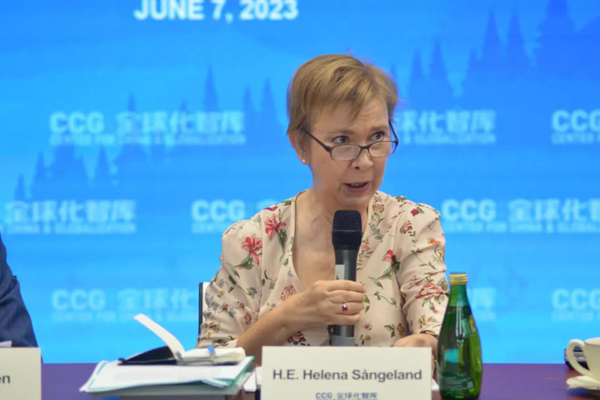H.E. Helena Sångeland Speaks at CCG Ambassadors’ Roundtable
In an era of globalization, countries everywhere face daunting socioeconomic challenges. Inequality is rising. Cohesion is weakening as societies undergo identity crises. As governments in search of role models for governance, equality, and social and economic policy, the so-called Nordic model often ranks the top. Practiced in Nordic countries, including Sweden, Norway, Denmark, Finland, and Iceland, the Nordic model is characterized by a state welfare system, access to quality education, and low income disparities, which contributes to the countries’ continued growth and prosperity.
China shares the Nordic countries’ drive to combine market economy and government intervention. As the country seeks to transform its economy and address challenges due to unfettered growth in the past decades, the Nordic experiences may shed light on possible pathways toward the national goal of common prosperity. This event provides highly contextualized accounts of the Nordic model and a discussion about its relevant applications for the future.
At the Center for China and Globalization (CCG) the Ambassadors of the five Nordic countries, Denmark, Finland, Iceland, Norway and Sweden presented different aspects of Nordic governance and practices, including fiscal policy, education, parental leaves, demographic policy, resource management and sustainability, and exchanged views with Chinese scholars and officials on how China can learn and build on Nordic experiences and practices as it works to meet its national goal of common prosperity.
Presentation by H.E. Helena Sångeland, Ambassador of Sweden to China
The topic of my intervention today is addressing the demographic challenges in Sweden from an economic perspective. When we talk about demographic challenges, over-population is still a major problem, and human population has grown beyond a sustainable means. We are consuming more resources than our planet can regenerate with devastating consequences, and this goes particularly for richer countries, like my own. More people mean an increased demand for food, water, housing, energy, house care, transportation and more, and all that consumption contributes to ecological degradation, and increase conflicts and a higher risk of large scale disasters like pandemics.
This is a very important topic – how to grow the world population in a sustainable way. But, the demographic challenge that I wish to talk about today is from an economic perspective, because many countries are grappling with lower birth rates, and aging populations, which increases costs to the economy, pressure on health services, competition for jobs, or decreased participation in the workforce, potentially less funding for young people, and an increased dependency ratio.
Population growth,,on the other hand, will lead a higher tax revenues, which can be spent on public goods, such as health care and education. By that token, it can be a good thing to have an increasing population. Sweden is just like our Nordic neighbors, one of the richest countries in the world, but we are also rich country whose population still grows, and ages, and this picture illustrates by year 2100, Sweden’s population is estimated to grow from today’s 10.5 million to 13.7 million, and in a Chinese perspective, that’s quite laughable, it’s the size of a fourth tier city in China, but it’s still growth.
Sweden is one of the few countries which will continue to grow, whereas others will decrease. Population growth in Sweden basically comes down to two factors: there is more births than deaths, and more people move to Sweden than move out. The policy challenge is to sustain a comparably higher degree of labor market participation, in order to support both our children and our elderly.
So what are the measures that Sweden has taken? In the 70s, which indeed was a decade of many reforms, we came to political consensus that we needed to create possibilities for women to both work and have family. The economy grew fast, and we needed all hands on deck, in our manufacturing sector and service industry. We also needed the population to keep on growing. So, what was introduced in the 1970s was a number of reforms, the provision of heavily subsidized childcare, equal for all. Municipalities have to provide for all children regardless of what hours their parents work, meaning provision of nighttime childcare for those who works as nurses and doctors and others who work nightshifts.
School is free so as to provide equal opportunities for all. There are also provisions of after school care, so that parents can work full time. Parental leave has gradually been increased to what we have today. A child can have one parent on paid leave for almost one and a half years, and with 80-90 percent of the leave paid. This parental leave must be shared, so at least one parent needs to take out a minimum of three months of the one and a half years. As you can see on this graph that fathers’ share of all parental leave days has increased tremendously.
For instance, when I get new staff at my embassy, young men in their 30s, if they are married or living with a partner, I can be assured that they will ask for six months of leave, although they are posted abroad and they are entitled to it. Just as mothers they are also entitled to take their leave for six months.
Universal child allowances are also provided and increase with the number of children that we have. Maternal and under-five mortality rates are low, and we have laws in place to hinder employer discrimination against pregnant women or to-be parents. We don’t discriminate against men or women, although it is the case that women still taken more parental leave than men, but the difference is shrinking.
What these reforms did, apart from allowing women and men to both work and have children, was that they transferred a lot of work from informal to the formal sector. Such as household chores have become jobs, which has a lot of spin-off effects like increased taxation and revenue. As a bonus, people don’t need to save up for day care, school, universities and elderly care.Thus they have more money and incentives to spend on consumption, in turn driving economic growth. Labor participation of women is today 71%. It’s still lower than that of men, which is 76%, but from an international perspective that’s rather high.
That’s not to say that we don’t have a lot of challenges, women still work more part time than men, they have lower salaries and higher unemployment, but we’ve come far during the past 50 years. Another factor affecting the labor force is how long we work; we are fortunate enough to have people living longer and healthier lives. Life expectancy has increased by almost 10 years for men and 7 years for women over the past 50 years, to 81 and 85 years respectively. But that also means that older people need to be supported financially for a longer time, unless they work longer, which exactly what they are doing in Sweden. The earliest you can retire today and to receive public pension is 63, and you have the right to choose to work until 69 and if you and your employer want, you can also continue longer than that.
Retirement age is constantly raised in pace with life expectancy and you have economic incentives for working as long as possible. The longer you work, the higher your pension will be. A remaining challenge is to improve working conditions for those carry out physically demanding occupational activities. For example, women who work as nurses, with long hours and heavy lifting of patients, we have to ensure that they have bodies and minds in shapes to enjoy retirement after 45 years of working.
And, of course, we also have immigration. Despite all our advances, the fertility rate in Sweden is 1.6 per women, and higher than that in most developed countries, but still not high enough to tip the scale in favor of population growth in the long run, even there are more babies born than those who die.
In the 60s and 70s, during our manufacturing boom, we would never have been able to make it without immigrants from our neighbour Finland and southern Europe. Today we have newly arrived refugees from war zones such as Afghanistan, Iraq, Syria, Eritrea and Ukraine, who are working in our services sector, taking care of our elderly and our children. Others are highly skilled immigrants advancing our technological and scientific development.
Although there is no lack of challenges, they largely contribute to how we have overcome the demographic challenge that so many countries meet at a certain stage of economic development. About 20% of Sweden’s population is born abroad (i.a. if you have two parents born abroad).I, for instance, am part of that immigrant population, because my parents were born abroad, they were born in Finland can came to Sweden to find a work in the 50s and 60s.
There is no one simple solution to address demographic challenges, but there are many measures can be taken that combined come a long way. Thank you very much.







